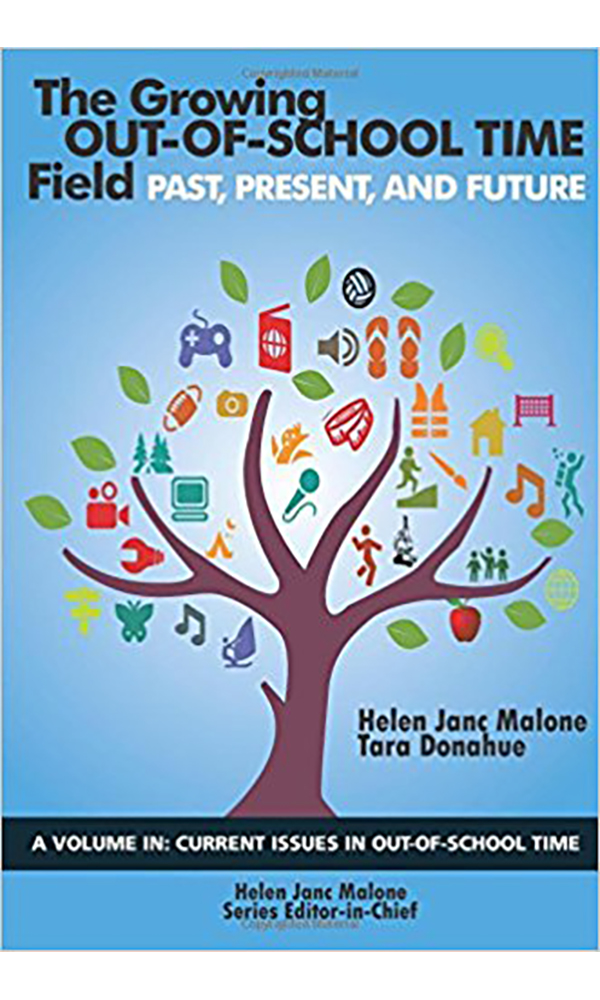
The Growing Out-Of-School Time Field Past, Present, and Future | By Helen Janc Malone and Tara Donahue | Series: Current Issues in Out-of-School Time | Information Age Publishing | 2017 | 348 pages
“The Growing Out-of-School Time Field: Past, Present, and Future” is, above all else, an attempt to unite the out-of-school time (OST) field, which spans multiple disciplines and contexts and is often defined more in terms of what is not and less in terms of what it encompasses.
This book, the first volume in an intended series, is promised to be the “beginning of a conversation on the pressing matters facing the field and the paths that could chart the course for the field’s future.” Not only does this book deliver on that promise, it exceeds it: The authors provide a common foundation for all individuals interested in the OST field, centering on strengths of past accomplishments and areas that need to be further developed, while providing clear examples of ways in which the field can be systematically improved.
Above all else, however, the book is a call to action, challenging the field to grow with intention, to reach the youth who need it the most, and to work diligently at creating positive opportunities for all youth.
This is an easy-to-read collection of topics relevant to the field that provides information for everyone: research-based suggestions for practice, with examples of applications from the field, and implications for policy are prevalent throughout. The chapters take readers from across the OST field on a journey, documenting what is well-established in the field, why programming matters and what the research means for practitioners, researchers and policymakers with the clear goal of improving the field and improving the impact OST programming has for all youth.
Editors Helen Janc Malone and Tara Donahue organize this volume into six sections that naturally build on each other. They use common understandings, goals and directions to unite readers who might be otherwise segmented into different sectors or roles within the OST world. The structure set forth in this book provides:
- A clear and detailed understanding as to what constitutes high-quality OST programming and the impact such programming can have on positive youth development
- A rationale and guidelines for expanding access to opportunities for high-quality programming and
- Practical considerations for improving OST programming.
The first section is organized around the role OST has in youth development, providing an update on what has occurred in the field since the turn of the century. In the second section, “Socio and Cultural Dimensions in OST,” access to programs is the major point of consideration. The final four sections dive into key aspects of OST, such as the role of professional development for OST staff, the role of research and evaluation, the advocacy that can occur from representatives in the field and future directions for the field. In each section, research is presented and coupled with examples from the field and considerations from practitioners and policymakers alike, bringing together many different ways of thinking through the issues.
This book consolidates research from the past 15 years, outlining the key issues of the field in a digestible fashion. With that foundation laid for the reader, the book transitions to a call to action of sorts, encouraging professionals from multiple types of programs and from different roles to share their experience, perspective and expertise in a way that moves the field as a whole forward toward a shared goal.
One of the best things about it is that it has something for everyone: researchers, practitioners, policymakers, youth advocates, etc. The breadth of topics ensures that. Although some chapters may not be of interest for all readers, there are likely to be several topics that individuals will feel speak to their specific interests and role in OST programming, lending insight in a way that speaks to improved practice.
However, the second section of this book is a truly critical contribution; everyone should read it. These authors bring forward evidence of inequality within the OST field, shining a spotlight on issues that need to be addressed by policymakers, educators and researchers. The lack of access for youth in areas that are classified as low socioeconomic status and high-risk, young men of color, LGBTQ youth and English Language Learners (ELLs), is discussed with examples of successful solutions from the field. The reader is left feeling motivated to return to the field and make necessary changes that ensure quality programming is present for all youth who need access.
The book presents a systematic approach to making change in the development of all youth with the use of OST programming and is an ideal resource for anyone involved in the OST field. It provides a fresh, thorough and much-needed perspective for researchers, practitioners and policymakers and establishes a common understanding. As a result, the reader leaves with a better understanding of the OST field, the players involved, the joint mission and the motivation to continue to strive for improvement.
Theresa Melton, M.Ed., has extensive experience in the out-of-school field and is currently a doctoral student at the University of Virginia where she studies positive youth development within the context of after-school settings. She also works as a research specialist for the National 4-H Council.





























